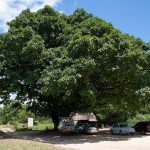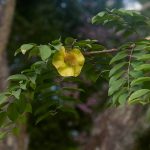TREE LIFE
May 1982
MASHONALAND CALENDAR
Tuesday May 4th : Botanic Garden Walk. Meet in the car part at 1646 for 1700 hours.
Sunday May 16th : 0730 hours. We shall make an early start as we have a long way to go to Japo Estate, home of Mr. and Mrs. Roger Green in the Gadzema District where we shall be looking at the vegetation on the banks of the Umfuli river. Bus booked and booking slip attached.
Learner Group : Mrs. Gill Masterson continues to hold meetings for a few beginners at a time, to introduce them to the identification of trees where only a selected number of species are studied so as not to overwhelm the learner with too many facts. If you would like to be included in this group please contact Mrs. Masterson on 303435 between 6 – 0630 hours or in the evenings and she can advise you of a time and place for the next meeting.
THE BOTANIC GARDEN WALK ON APRIL 6TH
This was once again well attended, not really surprisingly, and as usual we spent a fascinating hour.
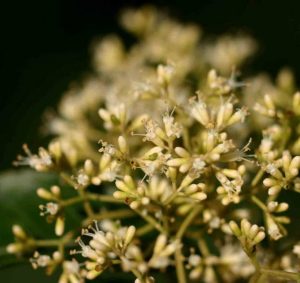
Nuxia floribunda. Photo: Bart Wursten. Source: Flora of Zimbabwe
While we waited for Tom Muller who had previous visitors we admired a Nuxia floribunda in flower. As the name suggests it was abundantly covered in masses of heads of creamy flowers. There are three members of the Nuxia genus in this country; N. floribunda and N. congesta which both have leaves in whorls of three and which occur in forest areas including the Matopos and thirdly the one with which we are more familiar, the River Nuxia, Nuxia oppositifolia, appropriately named because it has opposite leaves and occurs along rivers. It can be confused with the Wild willow, Salix subserrata but that has alternate leaves with a finely serrated margin. The leaf margins of N. oppositifolia are entire, wavy or bluntly toothed. Nuxia belongs to the family LOGANIACEAE, as do Strychnos and Buddleja.
With Tom’s arrival we set off to have a look at some of the trees we may see on our visit to Shamva including some riverine species which may occur along the Pote River. Cordia pilossissima, woolly Cordia, with very velvety leaves was in fruit which look a bit like an acorn. This tree is usually found in the area between the woodland and the riverine vegetation. In flower was the River Dombeya, Dombeya kirkii, in habit rather like D. burgessiae but with a much narrower leaf. In neither flower nor fruit (which is good eating) was Garcinia livingstonei with its branches and leaves characteristically in 3’s with the yellow sap not very conspicuous. I think at the end of the growing season this is very often the case.
Terminalia sambesiaca occurs along the lower Mazoe River and could occur along the Pote. It has the characteristic layered appearance of a Terminalia but is the only member of the family with a smooth bark. Perhaps as a riverine species it does not have to contend with the fire hazard. We looked at two Albizias, both bipinnate as are Acacias and they belong to the same family MIMOSOIDEAE. The Albizias are unarmed and have a gland on the petiole which is characteristic. Some Acacias also have a gland but they probably have them along the rachis as well. This is something we must look at. Of course Acacias have conspicuous thorns, spines or prickles! Albizia versicolor is the Poison-pod Albizia so called because the green pods blown down in a storm are often poisonous and cause cattle deaths, although apparently when dry they are eaten without harm. It has round leaflets, large for the family, up to about 5.5 x 3cm, very velvety and there are also present 2 stipels looking like a pair of horns at the base of the pair of leaflets next to the petiole. The definition of stipels is “two secondary stipules at the base of a leaflet”. On the other hand Albizia harveyi, sickle leaved Albizia had tiny leaflets and if stipels were present they were too small to see. A. harveyi has asymmetric leaves looking like a crescent moon, or a sickle, or as someone suggested like little bananas. A. amara and A. brevifolia also have very small leaflets but theirs are straight. However A. amara has velvety young branches and leaves while those of A. brevifolia are glabrous, without hairs.
Lannea stuhlmannii was another species with a pinnate leaf, this one once pinnate and the leaflets had no petiolule (leaf stalk of a leaflet). Balanites aegyptiaca with its paired leaf and simple thorn occurring together made it unmistakable and distinct from the other species B. maughamii which has a Y-thorn. Also with thorns was Oncoba spinosa which looks like a rose when in flower, has fruit which look like miniature gem squash and leaves with evenly serrated margins. I would love to find Phyllanthus engleri in the bush. This has branchlets which behave like leaves and are deciduous. The small round simple leaves occur along one branchlet does not fall but stays on to become a lateral branch from which the others arise. Xeroderris has a red sap like the Mukwa, Pterocarpus angolensis, and leaves with some leaflets that look a bit like “hangers-on”.
Acacia nilotica was distinctive with its sweetly scented pod, markedly constricted between the seeds so that it resembles a strip of Aspro. Close by was Acacia gerrardii which is similar to A. nilotica, but has the young branches covered with dense white hairs among which are orangy red spots or lenticels, quite visible to the naked eye and which are diagnostic. And as the light
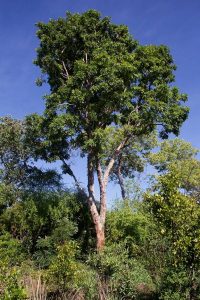
Pericopsis angolensis. Photo:Petra Ballings. Source: Flora of Zimbabwe.
was fading we passed Mwanga, Pericopsis angolensis with its alternate leaflets, the terminal one hanging down at an angle and Carissa edulis, its flowers sweetly scented and characteristically as a member of the family APOCYNACEAE it had opposite leaves and milky juice.
Thank you Tom for a most enjoyable walk and I hope that the tips you have given us will be remembered in the field on our trip to Hopedale Farm.
VISIT TO HOPEDALE FARM 18TH APRIL 1982
We were delighted to have Miss Val Deas from the Matabeleland Branch join us on the outing to Hopedale Farm.
Dick Petheram has done the write-up and it gives me great pleasure to include his contribution to that lovely day.
The Pote Valley beacons in various, orthographical guises. Independence Day name changes have not caught up with them. The road sign beyond Bindura reads “Pote”, while sundry maps and documents refer to “Pote” and “Poorte”.
However, these inconsistencies are of little moment. There is nothing variable about the warmth of hospitality of the Valley farmers, and on Sunday, 18th April we were fortunate enough to sample that hospitality at the home of Mr. Hugh Taylor and his sister, Miss Barbara Taylor, on Hopedale Farm.
On being ushered into the homestead for a sumptuous morning tea, we had the added pleasure of meeting other valued friends of the Society, Mrs. Janet Liddle whose late husband Clive, a cousin of the Taylors, was a well known authority on the trees of the district, and Mrs. Bobs” Bayley, with whom our members had spent the day at Danbury Park, Mt. Hampden, as recently as January, when Bobs and husband Tom were our hosts.
Hopedale has been in the Taylor family since 1922 and has been farmed by Hugh and Barbara since 1937. It was tempting to dip and delve into the rich store of reminiscences of early farming (and mining) days, and to indulge in fanciful visions of gracious living of the past, conjured up by such family heirlooms as the magnificent samovar in the lounge, so it was some time before we turned our attention to trees.
It was of interest to learn that, of the baobabs growing on the lawn, the bigger of the two had been planted with a liberal supply of elephant manure because, at the time, it was believed that baobab seeds which first saw the light of day within the snug and nutritious shelter of an elephant dropping was blessed with the best of all possible starts in life.
Hugh had gone to great pains to clear a track for us up the kopje behind the house. There was something of interest at every turn, and we found of significance, a range of species tolerant of the highly mineralised soil.
In general, there was variety rather than size, and had there been time for a more detailed analysis, it could have been of value to record more precisely the incidence of coppice growth resulting from the bush clearing which was undertaken for security reasons in recent years, and the number and identity of those trees which were untouched, mature, but stunted, possibly because of mineralization.
On one section of the tract, mica glistened from every rock. The kopje had been tunnelled for tin in years gone by. Beryl and tantalite were also mentioned in the course of our climb. All these, I have from a geological report, can be associated with pegmatite intrusions – which Hugh told us was one of the geological features of the farm. Traces of nickel are also a problem, even in the cultivated lands. The smoke of the Trojan Nickel mine was clearly visible from one of the view points we stopped at.
One quaint result of coppicing was the flowering of some of the small mnondos, Julbernardia globiflora. Normally the flowering is over by February, or at the latest, March.
Some 80 or more trees and shrubs were noted. A tree that caught the eye early on, we assumed at first to be Acacia goetzei, subsp. microphylla. It’s hooked, paired thorns and the proliferation of tiny dark leaflets seemed typical. It was only when we found, in a couple of these trees a little further on, a leaflet here and there, noticeably larger than the others, that doubts began to dawn. Specimens were therefore collected from each, and they proved our doubts well founded. They were all A. goetzei subsp. goetzei. Some trees of the same species had pronounced bosses on the trunk, phenomenon we knew the species shared on occasions with A. nigrescens (the knob thorn). The later, however, has only one or two pairs of leaflets to each pair of pinnae. Regarding the two subspecies of A. goetzei, J.P.M. Brenan in Flora Zambesiaca indicates that the mature leaflets of subsp. goetzei are nearly all more than 3mm wide, sometimes considerably more, usually widest towards the apex, and generally limited in number to between 5 and 11 pairs; whereas in subsp. microphylla the mature leaflets are usually narrower than 3mm, linear or linear-oblong in shape except for the terminal pair, and generally more numerous than in subsp. goetzei – 8 to 23 pairs. The pressed specimens of subsp. microphylla kindly shown to me subsequently by Mr. Gerald Pope of the National Herbarium brought out the linear-oblong feature very clearly. Gerald also drew attention to the fact that the numerous narrow leaflets were inclined to be falcate (slightly sickle-shaped) and fairly “discolor” on the under surface.
Other species of Acacia were A. gerrardii, A. polyacantha, A. karroo, A. amythethophylla (formerly macrothyrsa with less of a “lytho” and A. nilotica. The last but one was in flower and pod.
Among the most striking of the other trees were some violet trees, Securidaca longipedunculata, in pod, a fine specimen of Kirkia acuminata, known as the white syringa, a Xeroderris stuhlmannii and one or two well shaped cabbage trees, Cussonia arborea. Several Kirkias, Cussonias and Xeroderris were also coppicing.
The vicious spines of Xeromphis obovata were in evidence in many places. This shrub of the RUBIACEAE family is aptly named the thicket Xeromphis in “Palgrave”. It can spread alarmingly. The white gardenia like flowers are attractive, although smaller than Gardenia and not particularly long-lasting, and the fruits, of which we saw many, are also gardenia-like in miniature.
The numerous rubber trees, Diplorhynchus condylocarpon, were to be expected. They are happy at that altitude, about 3450 feet, or 1050 m, and tolerant of mineralisation as we know from the Dyke.
Among the attractive and certainly the most numerous, of the flowering plants was the small cornflower Vernonia, Vernonia glabra. Cassia singueana was coming into flower, heralding the changing seasons as is expected of our winter cassia. The climber, Clematis Clematis brachiata , traveller’s joy, was refreshingly, in bloom.
Olax dissitiflora came our way again for, I think, the third time in the last few months. It is a tree/shrub which sometimes eludes us for months on end.
The COMBRETACEAE were represented by Combretum apiculatum, C. collinum, C. fragrans, C. molle, C. zeyheri and on the Pote flood bank in the afternoon, the river Combretum, C. erythrophyllum, I was down near the Pote River too that we collected an excellent specimen of Terminalia trichopoda, which was accommodating enough to show clearly on several stems the flaking bark near the terminal clusters of leaves. This is a characteristic which it shares with T. sericea and, I gather from Mrs. Masterson, with T. brachystemma, but not with T. stenostachya which it otherwise resembles. The round-leaf T. mollis was also there.
The Mazoe and Pote hills and dales always produced a number of edible fruiting plants. In my experience one can usually expect about 25% of the trees and shrubs seen in a day’s outing to be species which bear edible fruit at some time during the year. Hopedale was no exception. The relevant species we saw were, in alphabetical order, Annona senegalensis, wild custard apple;
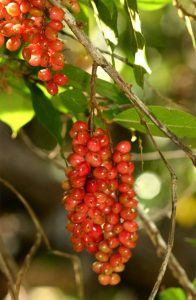
Antidesma venosum. Photo : Bart Wursten. Source: Flora of Zimbabwe.
Antidesma venosum, tassle berry; Azanza garckeana, Bridelia cathartic, Cissus cornifolia, wild grape; Diospyros kirkii, mushenje; Diospyros lycioides, red star apple; Flacourtia indica, batoko plum; Friesodielsia obovata, sometimes called monkey fingers; three species of Grewia, Grewia hexalobus, Grewia monopetalus, Palgrave’s shakama plum, also known as baboon’s breakfast; Securinega virosa, snowberry; Strychnos spinosa, monkey orange; Syzygium quineense, waterberry; Vangueria infausta and Vangueria randii, both wild medlars; Ximenia caffra and X. americana, sour plums; and Ziziphus mucronata was also around somewhere, but I am not sure that we spotted it on that outing. Ozoroa reticulata has been omitted because, although reputed to be edible, it tastes ghastly.
The Grewias, incidentally, were G. monticola, G. pachycalyx – with the 4-lobed fruit, and G. subspathulata, found and brought in for confirmation by Mrs. Masterson. The leaf has a very asymmetric base and the grey under surface is clearly patterned with prominent rusty red veins.
After a relaxed lunch on the shaded lawn of the homestead we were guided by Hugh to a picturesque bend in the Pote, at its confluence with the Nyamasanga tributary. En route by bus we passed a stand of red Bauhinias, B. galpinii, in flower, and on the approach through the vlei, a Syzygium quineense and almost certainly a large Ekebergia capensis. Osyris lanceolata was also one of the early afternoon finds. Phyllanthus reticulatus, the Lowveld shrub which, when in flower, wafts its “potato smell” over one’s fishing camp in the evenings, caused a little excitement, because we don’t stumble upon it with much frequency nearer home. Its other claim to fame is that it’s simple leaves are, to quote “Palgrave”, page 401, “so arranged as to give the impression of compound leaves”, a device obviously intended by nature, further to confuse amateur botanists like us. We had already seen the closely related Margaritaria discoidea on the kopje in the morning. It was until recently known botanically as a Phyllanthus.
The rough leaf Ficus capreifolia with which we are now becoming better acquainted, party through encounters and party through Mr. Muller’s graphic references to it, was also down near the river. A sparsely fruiting tassel berry bush, Antidesma venosum, showed up with leaves of a matchless deep glossy green. There were some large Vangueria randii bushes with fruits unfortunately past their prime. Clumps of the willowy river Rhus, Rhus quartiniana, adorned the river bank. The margins of most of the leaflets were entire, but, unexpectedly, some were very artistically scalloped. The presence of the Jasmine tree, Holarrhena pubescens, topped with cream our already brimming cup.
We left Hopedale after a thoroughly relaxing and rewarding day, full of gratitude to Hugh and Barbara for all they had done for our enjoyment.
Meg then proceeded to direct the bus seemingly straight into the teeth of a colossal storm in her determination to seek out the grove of Cordia abyssinica trees at Woodlands Farm on the circular route home. If anyone felt any trepidation, it was groundless. When we rounded the corner of the dirt road which brought the trees into view, the dark glowering clouds served to heighten the glory of the magnificent stretch of foamy white which miraculously appeared. The trees were at their best, bursting bud and freshly opened flower. There was spontaneous applause as we drank in the sheer beauty of the scene, and after a few intrepid souls had jumped off the bus and braved the first big spattering of rain to collect sweet-scented sprays of flowers and leaves to hand around, we headed back to the city, well content.
-R.W.Petheram
Thank you Dick and thank you Barbara and Hugh for your hospitality and all you did to make our day a happy one.
MATABELELAND BRANCH CALENDAR
Sunday May 2nd : We want to make a return visit to Kloof Farm and adjacent area to investigate further the interesting variety of vegetation which we by no means exhausted in March. The turning off the Nyamandhlovu Road is 20km from the Falls Road. Meet at the City Hall Car Park at 0830 and bring lunch.
Sunday June 6th : To the Central Area of Rhodes Matopos National Park. Meet at Retreat Shopping Centre at 0830 hours.
Tree Note from Deuteronomy 20:19 – “when you are trying to capture a city, do not cut down its fruit trees, even though the siege lasts a long time. Eat the fruit, do not destroy the trees; the trees are not your enemies. You may cut down the other trees and use them in the siege mounds, until the city is captured”.
“The Green Escape” and other nature films are held by the Central African Zionist Organisation.
It its April field meeting the Matabeleland Branch names trees on the Pomongwe Hill, a granite dwala. A walk has been planned by National Parks leading from the tarred road over the hill and down to the Cave.
Strychnos matopensis was fruiting, Nuxia congesta, N. viscosa, grows there in high and sheltered places, and the Ficus species were interesting, Ficus glumosa, Ficus tettensis and F. natalensis.
-Janet Webber
NOTABLE TREES OF ZIMBABWE
We have received a letter from Mr. L. J. Mullin, divisional Manager of the Forestry Research Centre, Forestry Commission, headed “Notable Trees of Zimbabwe”. In it he expresses concern that a number of old indigenous or exotic trees have been unnecessarily destroyed to make way for new plantings or other development. He proposes to bring these trees to the attention of all through the words and pictures of a suitable book, which would make it difficult for any felling to take place without very good reason.
Attachments to this letter consist of addresses to which it was sent and a fascinating list of the interesting trees already known, for example :
a The big tree, Khaya nyasica, in Chirinda
b Forest Eucalyptus grandis at Nedzi farm, Penhalonga; perhaps the tallest in the world
c Two baobabs on either side of the road from Chipinga to Birchenough Bridge, known as the “Gateway to Gazaland”
d Large fig (Ficus vogellii?) near Chikore Mission, Chipinga District, which was used by R.A.F. trainees as a visual navigation aid during World War II, it is still a very prominent land mark in the district
e Exceptionally large Jacaranda at the main police station, Salisbury
f A stand of Eucalyptus regnans at Stapleford Forest which featured in the 1971 Guinness Book of Records as having attained a height of 100 feet in the shortest known time, seven years, and many others.
Who better equipped to add to this list, as he requests, than members of the Tree Society? Anyone who knows of a tree, or anything about trees that is of interest, please contact Mr. Mullin, P.O.Box HG 595, Highlands, or telephone 46879 or 791997.
Recently I realized that what I have always spelt rachis “Flora Zambeziaca” spells Rhachis. Brian Best started the research which Paul has completed and now comments :
Rachis vs rhachis
There is no doubt that, correctly, it should be spelt rhachis but has been used so commonly without the first ‘h’ that this has become an equally accepted alternative. In fact Henderson’s Dictionary of Scientific Names gives all the information under rachis and looking up rhachis refers you back to it.
William T. Stern’s Botanical Latin gives the following fascinating explanation upholding my first sentence. In the Greek alphabet a backwards comma above a small letter means that the word originally started with an ‘h’ and is the rough breathing sign, spiritus asper. A small letter with nothing above it indicates the smooth breathing sign, spiritus lenis, and means that the word does not have an ‘h’ in front of it and I refuse to complicate the issue by explaining the upside-down, back-to-front, inside-out apostrophes and commas that appear in the front of the capital letters and which all mean different things, and please note that all the apostrophes, commas, quotes etc. that I have used in this article mean only what they usually mean.
To continue, the small letter sign for ‘O’ or omega when used in the word ‘oros’, meaning time, has a backwards comma over it so the word should be “heros’ and this is acknowledged in the English words, hour, horoscope, horology, etc. the Greek letter ‘r’ is written like a ‘p’, how difficult can you get, and when used for ‘rachis’ has a backwards comma over it which means that it should be hrachis’ which, being unpronounceable, becomes rhachis, meaning ‘spine, backbone, ridge’. This letter is responsible for words such as ‘rhizome’, ‘rheumatism’ and ‘rhythm’ but equally been corrupted without the ‘h’ for ‘radish’, ‘rose’ and ‘rachis’.
To wax lyrical in the Best fashion
When learning trees in Greek, “H” forbid,
The mHidrib and the spHine and the bHackbone did
Teach you just enough so that you knew to miss
The first of the Haitches in the re-Hay-chis.
Chorus : my weh!
N.B. Stearn’s book does not refer to a little letter as I have done for the sake of clarity, but to a little character which I thought you might confuse with our Chairman.
-P.Coates Palgrave


